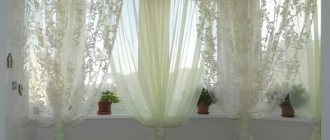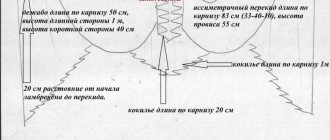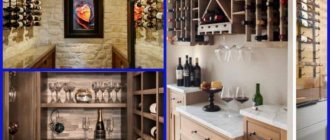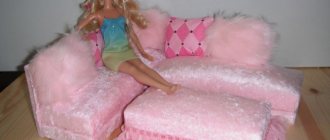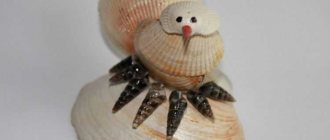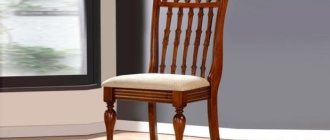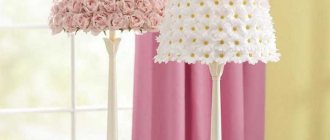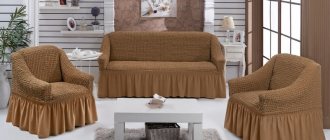The kitchen is the place where there is increased pollution. For this reason, we try to choose materials for this room that are easy to clean, wash quickly, and do not collect dust and dirt. We try to avoid various decorations, because they are often the largest dust collectors, and given that in the kitchen dust mixes with grease and becomes sticky, it is really better to refuse decorations.
Lambrequins for the kitchen should perform not only a decorative function, but, first of all, be practical.
This rule applies to any surface: floor, ceiling, table and windows. Decorating windows in the kitchen is a separate topic. More and more housewives are moving away from the usual curtains and curtains in the kitchen, replacing them with roller blinds or blinds. However, in ancient times, the kitchen was one of the important places in the house, especially since in the modern world the kitchen also includes the functions of a refectory, or, in modern terms, a dining room. And this area was decorated quite luxuriously: stones, large and heavy curtains on the windows, lambrequins and many other decorations.
The room and windows decorated with such decor acquire an elegant, bright and solemn appearance.
Wanting to bring former luxury back into fashion, some modern designers propose to decorate the kitchen in the Baroque or ancient classic style. It is worth mentioning that modern classics differ from standard ones, or as we called them ancient ones. Therefore, we made a clarification that lambrequins and other decorations are suitable for kitchens in the style of standard or ancient classics.
Such fabrics can give the room a solemn and very elegant look.
If you decide to decorate your kitchen in a classic style, but do not want to use the services of a designer, you can try to start with window decoration and make lambrequins for the kitchen windows with your own hands.
The canvases fall in beautiful, lush folds.
What is a lambrequin and what is it intended for?
Lambrequins came to us from France; in fact, the name is also French. This decorative element is a strip of fabric that decorates windows along the cornice. It can be short, medium length or long; curvy or flat.
Allows you to hide the cornice and fastening system.
Initially, short canopies on the bed were also called lambrequins. Then they began to decorate windows using this method. This element was used in the luxurious Baroque and Rococo styles. Canopies were made from expensive fabrics of bright colors with the obligatory inclusion of gold-colored thread. They were often decorated with embroidery made from such thread.
This decorative element is attached to the pipe at the edges or in the center.
In their modern form, there are many different types of lambrequins. Some have not lost their former luxury, others have adapted to the modern style and have become less noticeable and pompous. Among the types of modern lambrequins we highlight the following.
- Soft. They are sewn from various fabrics by assembling. This way they form beautiful folds. Curtain tape can also be used to make them. Soft models can be either folded or even.
- Bando. This is a type of solid lambrequins. They are made using a rigid base onto which fabric is stretched or glued. Bandeaus can be made of wood or cardboard, without the use of fabric.
- Combined. In this case, the first and second types are combined. For example, a bandeau is placed on top of the cornice, and below is a soft lambrequin with drapery.
Each window has its own form of drapery for decoration.
In modern design, this element has not only an aesthetic, but also a practical purpose. It allows you to visually smooth out small irregularities in the window and hide the cornice.
A rigid lambrequin has the appearance of a semicircle or rectangle with a figured or smooth edge.
Most often, this element is used in the living room, since this room often has large windows, and such a bulky design can be applied to them. However, it is also suitable for the kitchen or bedroom. But in this case, you need to choose a less flashy design and lighter fabric.
They can add completeness and expressiveness to the image of the entire room.
Decorative elements
To sew the curtains with lambrequins of your dreams with your own hands, for example, in a spacious kitchen with large windows, a kitchen-living room or a dining room, you can choose one of the spectacular decorative elements:
- Swag - a semicircle draped with folds, a shell located horizontally, can be made symmetrical or not;
- De jabot - a side element, a “jabot” with a lower bevel (or located in steps), thanks to the de jabot, a hard or soft lambrequin acquires a vertical position;
- A tie is an element with folds along the edge at the top;
- The mold is a flared assembly in the center, which is usually located in the center of the lambrequin between two swags.
Do-it-yourself lambrequin for the kitchen: step-by-step guide
Sewing a lambrequin is not as difficult a task as it might seem at first glance. If you approach the matter responsibly and do not miss all the preparations, the product will turn out good.
The photo shows a jabot with a floral pattern in the kitchen interior.
Important! Don’t rush to see the result faster by skipping stages of work. Patience is required here.
Hard type
The technique of sewing rigid window decorations has become easier with the production of the latest self-adhesive fabric - thermoband. With it, it became possible to make excellent, perfectly created curtain designs with your own hands, having the pattern diagrams.
Correct tailoring of this model depends on the sequence of tasks performed:
- the pattern is transferred to the adhesive fabric itself and cut exactly along the line, there is no need to add allowances;
- a similar part is cut out from the main material, taking into account the reserve;
- Using a steam iron, solder the material to the base. Soldering begins from the center of the product, this way you can avoid distortion of the pattern;
- it is advisable to decorate the edges with some kind of decorative tape;
- Attach Velcro tape to the wrong side, which will hold the frame.
Sketches, stencils, photos of lambrequins
Before sewing a lambrequin for the kitchen, look at the proposed photos and choose an example that you like.
They look impressive when decorating tubular cornices.
Then draw a sketch of the future product. You can copy one of the presented photos, or add your own idea to it. Or you can create a sketch of the lambrequin yourself, and this will not appear in any photo.
This form is mainly used for wide window openings.
When choosing a basis for a sketch, take into account the following factors:
- window width and length;
- amount of free space around;
- the distance of the window from the stove, sink, cutting and dining table;
- presence of children and animals in the house;
- room style;
- interior color scheme.
Can be of different lengths depending on the height of the window.
Now you can create your own stencil, which you can then use to sew the product.
Designs for a nursery or bedroom
A simple but very beautiful lambrequin called “Scarf”, complemented by formal curtains, can be placed in a bedroom or nursery.
See how to sew a product step by step:
- Let's determine the dimensions of the product. To prevent the swag or sagging from darkening the room, it should occupy no more than 6th part of the opening.
- Let's outline the height of the lambrequin;
- Fold the fabric in half, from its middle along the upper edge in both directions we mark ½ the length of the cornice, along the lower edge - the height of the sag;
- Connect the top and bottom points on each side, marking the line for sewing on the braid;
- Along the upper edge we will add the height of the folds to the width of the cornice. From the extreme point we draw a line down.
- Add allowances (2 cm each) to the resulting rectangle on the sides.
- We cut the fabric along the marked lines and bend it on all sides.
- Along the upper edge, equal to the length of the cornice and diagonal lines, we sew curtain braid.
Where the tape runs diagonally, we pull it together with the cords. Thus, we got a central swag with folds in a semicircle and coattails on the sides.
Tip: screed areas are decorated with decorative elements such as flowers and butterflies.
What material can it be made from?
We have a sketch, then we need to choose the fabric for sewing. A lot depends on the overall design of the kitchen, personal preferences and all of the above factors. Usually for the kitchen this element is sewn from light fabrics. Especially a lambrequin for a small window should not be made of heavy fabrics and create a heavy design. And in the kitchen, windows are often small.
There are many materials from which these curtain decorations are made.
So, the best options in this case would be the following materials.
- Chiffon. This is a light translucent fabric. It creates waves easily, is easy to work with and easy to assemble. The material is bright and comes in many different colors, which is especially beneficial for the kitchen.
- Organza. Curtains are often made from this material. It has a greater degree of transparency than the previous version and has a pleasant shine. When assembled, it forms hard, persistent waves.
- Tulle. Lightweight fabric designed for making tulle curtains. It is easy to sew, but does not hold its shape or folds well.
This design is complemented with tassels and fringe.
Drapery forms
Figured lambrequins are ordinary fabric that still needs to be decorated. The drapery method will help with this, that is, creating curly folds on the canvas.
The peculiarity of this method is that it creates the same atmosphere that is found in theaters and operas.
The formation of the drape can occur according to different patterns, which determines the splendor of the window opening. In total, there are 6 types of drapery, which have different folds and shapes.
Coquille. It is used for wide windows, where drapery with an acute angle is made in the middle. Silk-based fabrics are best suited.
Swagi. Even sagging of the fabric, with light folds. They can be symmetrical, one-sided, contrasting and plain. They are selected depending on the size of the room and the general mood of the interior.
Jabot. It is a modified swag. Drapery is done along the edges, without affecting the middle of the opening. It got its name due to the shape of the folds, similar to the French frill.
Crossover or half-swag. As a rule, it is used in a combination of two lambrequins. The hard canopy is installed in the standard way, and the second one is thrown over the eaves.
Tie. The structure of the tie is close to a frill, but has a specific knot, between which there are vertical folds.
Cascade. It is created from several lambrequins. Two of them go down, covering the canvas in the middle. This creates a trapezoidal segment.
How to make it correctly
It’s easy to make a lambrequin for the kitchen. Simply follow the instructions provided. For convenience, we will divide the work into stages.
Lambrequins look unusual and have a distinctive appearance.
Taking measurements
Measure the width of the window and the width of the baguette. Decide on the length of the product.
Also, don’t forget that you can use cardboard to form a bandeau.
Select the fabric, iron it, prepare the necessary tools (thread, scissors, French pins, sewing machine).
Stage "Pattern"
In accordance with the measurements obtained and the prepared sketch, make a pattern on the fabric. Cut the fabric taking into account allowances for folds.
Pattern of a lambrequin consisting of its two most common elements.
Overcasting
After cutting, the fabric sections must be processed with an overlocker, otherwise they will crumble.
Light and weightless flowing chiffon fabrics can add grace and elegance to windows and the entire interior.
Stitching
Now you need to assemble the lambrequin on the curtain tape, forming folds.
Tie lambrequins are usually used to decorate several windows.
The final stage is decoration. Hang the lambrequin so that it forms a beautiful segment and blends well with the curtains.
Imperial curtains
Such curtains are used to decorate windows. Creating a rich and pompous style, imperial curtains are not suitable for every interior. Being stationary, they are often complemented by Roman curtains or blinds. Such curtains are suitable for rooms with high ceiling heights.
It is best to sew curtains in this style from thick fabric that does not allow light to pass through. Velvet, plush, jacquard are ideal.
Before sewing curtains with your own hands, you need to decide what configuration will be implemented, how many trims will be on the curtain.
Let's look at the step-by-step construction of patterns for different options.
Curtains with one trim
To construct a pattern from point (∙) A downwards, set aside the height of the curtain in its finished form plus 20 cm for the top and bottom folds.
From A to the right we set aside the value AB, equal to the width of the straight part of the curtain, multiplied by K (drapery coefficient). Usually it is taken from 2 to 2.5.
From B to the right we set aside the width of the draped part of the curtain, multiplied by K.
From B and C we draw perpendicular lines down. On them we set aside the length of the draped part, obtained by measurement. This is the height of the cuts, determined according to your wishes. In the drawing BG = VG1.
We find point P as the middle of the segment GG1.
From P with radius RG1 we draw an arc. The position of point G2 is determined by the size of the main sag VG, which depends on your desire. Measurement of VG2 = VG.
From Г and Г2 with radius ГГ1 we draw two arcs. At their intersection we place point C.
From C with radius GG1 we draw the lower undercut of the drapery.
Please note that the accuracy of the resulting drapery depends on the accuracy of constructing the lines VG1G2 and GG2.
When sewing, we tighten the bottom hem of the drapery by carefully tucking it and stitching it with two machine lines, or finishing it with mounting tape.
Next, we grind the assembled part of the lower cut to the side cut of the HD.
We draw the contour of the lower cut DE arbitrarily, according to our wishes.
Curtain with two trims
Let's look at how the pattern is constructed in this case.
We measure the width of the curtain (= the length of the curtain rod) in its finished form - AD. We multiply this size by the drapery coefficient K = 2...3. We calculated the size for pattern A1D1.
We divide this value into 3 equal parts - two undercuts and a flat canvas.
The lengths BE and CF (highlighted in red) are set according to your wishes and are determined by the height of the undercuts.
Set aside B1E1=BE and CF=C1F1.
We complete two rectangles D1E1GC1 and C1F1HD1.
In the middle of segments E1G and F1H we place point M.
From M at an angle of 70° to the horizontal lines we draw straight lines and lay out the segments ME2 = MG and MF2 = MH on them.
With radii ME2=MG and MF2=MH we draw arcs GE2 and HF2.
From E1 and E2 with radius E1G we draw two arcs and at their intersection we place point Z. From this point we draw arc E1E2.
From F1 and F2 with radius F1H we draw two arcs and at their intersection we place point Z. From it we draw arc F1F2.
We received a pattern for a model with two undercuts.
We tighten the undercut E1E2 and sew it in the tightened form to the side line of the curtain B1.
We tighten the undercut F1F2 and sew it in a tightened form to the first undercut along the line F1E2.
There are many options for draping curtains, including the so-called false imperial curtain. The sewing pattern for the ribbon for such a curtain is shown in the diagram below.
The main problems when sewing lambrequins
The biggest problem is the inability to correctly calculate the required amount of fabric.
In order to give the cascades a zigzag shape, they are sewn with a lining of a contrasting color.
Remember! The size of the fabric determines the thickness and size of the folds on the lambrequin.
Please note that when assembled, the fabric tightens, forming folds. At the same time it becomes shorter.
Think in advance what the length of the lambrequin should be, taking into account the folds.
Combination of lambrequins with tulle in the kitchen
This element can be combined with a curtain or tulle. In the first option, the curtains are located along the edges of the window, and lambrequins, complementing them, outline the window from above. In the second case, the tulle completely covers the window, and the lambrequin complements it.
Curtain compositions made of satin create a festive atmosphere in any kitchen interior.
Important! The lambrequin and tulle must be attached to different strips of the baguette, since the first element does not move.
By placing the decorative element and the tulle on one strip, you will not be able to open the curtains.
It is better to choose a tulle color that is slightly different from the lambrequin by one or more tones. This will allow the tulle to stand out rather than blend in with the decoration.
Selection depending on window
Correctly selected curtains can visually enlarge or reduce a kitchen window, as well as emphasize the dignity of the style. The base with vertical stripes visually raises the ceilings, and the wide horizontal ornament expands the window and makes the wall a little wider.
Correctly selected curtains can visually enlarge or reduce a kitchen window, as well as emphasize the dignity of the style.
Small windows are decorated with lambrequins, which leave the opening and frame open. Folded structures are mounted above the window, which visually makes it larger. For small rooms with low ceilings, hard models are chosen.
Small windows are decorated with lambrequins, which leave the opening and frame open.
It is best to decorate a bay window with a soft frame with various decorative elements. If the kitchen has a window with a balcony door, an asymmetrical jabot will help balance its proportions.
It is best to decorate a bay window with a soft frame with various decorative elements.
For large windows, a combined look is suitable, where a hard base is complemented by soft drapery.
For large windows, a combined look is suitable, where a hard base is complemented by soft drapery.
See alsoPelmets for the bedroom
Design options
The design of this element depends primarily on the overall design of the room. If you have a kitchen in an old classic style and the room is quite large, then you can choose a bulky design with heavy fabrics.
The noble shine of this type of fabric lifts your spirits.
If the kitchen is of a modern style, leaning toward minimalism, give preference to light and delicate fabrics and light colors. This is especially good if the kitchen is small. This solution will allow a lot of light to enter the room, and the room will become visually larger. The lambrequin itself in this case will add coziness to the room.
Lambrequins made of nylon look quite attractive.
Don’t be afraid to experiment, but remember that it’s better not to weigh down the windows in the kitchen with bulky design and dark colors. Choose a lighter, lighter design. Bright window decoration is also acceptable. In this case, use this bright color in another element of the kitchen.
Fastening
The lambrequin is attached to cornices, window and door openings in different ways. There are fastenings with loops and ties. These are fasteners presented in the form of satin, satin bows, silk ribbons, rope cords or cotton laces.
Tie fastening
There is a lambrequin fastening to the eyelets. These are metal or plastic rings, available in different colors and sizes. Consists of a block and a leg. Art Nouveau, shabby shake and even vintage interiors are aesthetically complemented.
Eyelet fastening
Note! There is also a tape mount. This is a decorative fitting that allows you to attach curtains to cornices and openings using glue and Velcro
The most common model on all types of lambrequins.
In general, a lambrequin is a decorative transverse fabric strip that can be used to decorate window and door openings. They are able to give the room the effect of luxury and wealth. This design can not only make the room beautiful, but also emphasize its style, becoming a highlight. Lambrequin can be classic, soft, openwork, modular, plank and asymmetrical. Also available in bondo form. Can be decorated with a swag, half-swag, perekid, jabot, tie and puff. Easy to sew using the classic pattern and detailed instructions. Attaches with loops, ties, eyelets and Velcro strips.
